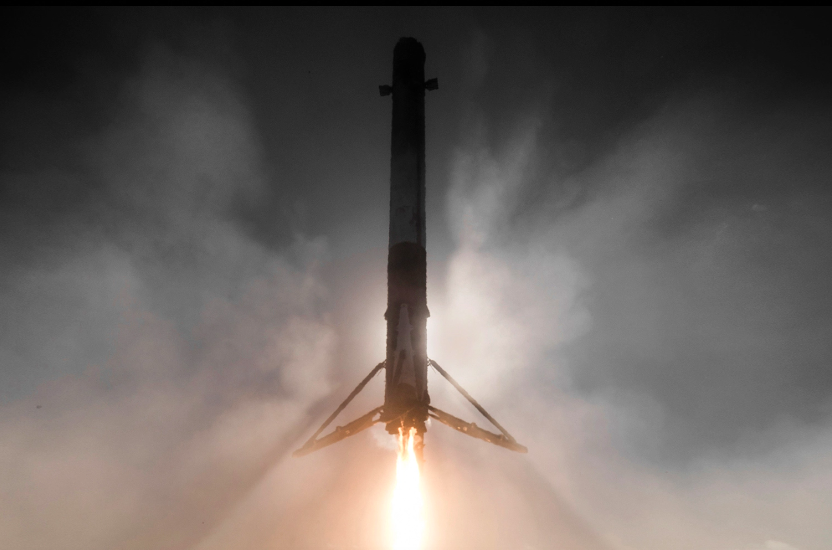
Falcon 9 lands on SpaceX drone ship “Just Read The Instructions.”
WASHINGTON: In advance of SpaceX’s planned launch of the fourth GPS III satellite on Tuesday, Space Force officials today revealed that the launch of the fifth bird next July for the first time will rely on a used Falcon 9 booster.
A contract modification signed at the beginning of this month with SpaceX allows for reuse of boosters for both GPS-SV05 and -SV06, Walt Lauderdale, SMC’s Falcon Systems and Operations Division chief, told reporters today. The changes, wrung out in a package deal across SpaceX’s four launch contracts for GPS III, is saving the Space Force a cool $52.7 million.
SpaceX and SMC successfully recovered the GPS III-SV03 booster after its June 30 launch, and plan to recover the booster from the upcoming launch of GPS III-SV04 using a drone ship. (SpaceX’s current drone ship is called “Of Course I Still Love You” — named after one of the AI-spaceships in the Culture series novel, A Player of Games, as a tribute to author Ian Banks.) It is the booster from Tuesday’s launch that then will be evaluated and re-used for GPS III-SV05, he said.
The launch of SV05 originally was planned for late January, but is being delayed because SMC and SpaceX need to put together a framework for evaluating the used booster’s ability to be reused safely, Lauderdale explained. Officials from the two sides will develop criteria under the “non-recurring design validation review of reuse” that can then be used to evaluate re-using boosters for future launches under SpaceX’s Phase 2 National Security Space Launch (NSSL) contract, he said.
As Breaking D readers know, SpaceX won one of the two coveted spots under the NSSL program on Aug. 7, alongside United Launch Alliance (ULA). The indefinite delivery/indefinite quantity (ID/IQ) contract for the two firms covers all Space Force and NRO launches between 2022 and 2027 — with ULA guaranteed 60 percent of those launches and SpaceX 40 percent. The Space Force currently plans some 34 launches during that time frame.
“As of today, SpaceX has launched 92 Falcon nine missions, which represents the most flown operational rocket in the us today. Of those, we have recovered 53 times, and have re-flown 38 times,” Michael Ellis, director, SpaceX’s National Security Space Launch head, told reporters today.
The launch delay will put back by a few months the ‘on switch’ for global coverage of the long-awaited M-Code for military users, but not significantly impact the schedule. The highly encrypted M-Code to protect GPS signals from jamming and spoofing currently is enabled on 22 GPS satellites of various generations; two more are needed for full coverage.
“This satellite, GPS-III-SV04 is the 23rd M-Code enabled satellite in the constellation, just one short now of the 24 needed for global coverage,” Tonya Ladwig, acting vice president of Lockheed Martin’s Navigation Systems Mission Area, said during today’s briefing.
She added that Lockheed Martin’s M-Code Early Use (MCEU) hardware and software upgrade package for the GPS Operational Control System (OCS) is on track to become operational by the end of the year.
The upgrade allows the M-Code to be used not just by GPS III, but by all older GPS satellites that are M-Code capable (GPS IIR-M and GPS IIF satellites.) It also allows M-Code functioning to be monitored by ground controllers, as well as supporting testing and fielding of user equipment, according to company officials.
“GPS III satellites provide a major step forward in both capability and resiliency compared to legacy GPS satellites,” said Col. Edward Byrne, senior materiel leader, SMC’s MEO Space Systems Division.
Norway’s air defense priorities: Volume first, then long-range capabilities
“We need to increase spending in simple systems that we need a huge volume of that can, basically, counter very low-tech drones that could pose a threat,” Norway’s top officer told Breaking Defense, “so we don’t end up using the most sophisticated missile systems against something that is very cheap to buy.”


























